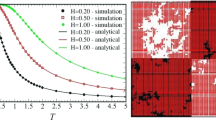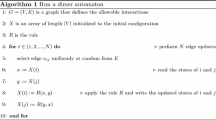Abstract
A random walk in \(\mathbf{Z}_+^2\) spatially homogeneous in the interior, absorbed at the axes, starting from an arbitrary point \((i_0,j_0)\) and with step probabilities drawn on Fig. 1 is considered. The trivariate generating function of probabilities that the random walk hits a given point \((i,j) \in \mathbf{Z}_+^2 \) at a given time \(k\ge 0\) is made explicit. Probabilities of absorption at a given time \(k\) and at a given axis are found, and their precise asymptotic is derived as the time \(k\rightarrow \infty \). The equivalence of two typical ways of conditioning this random walk to never reach the axes is established. The results are also applied to the analysis of the voter model with two candidates and initially, in the population \(\mathbf{Z}\), four connected blocks of same opinions. Then, a citizen changes his mind at a rate proportional to the number of his neighbors that disagree with him. Namely, the passage from four to two blocks of opinions is studied.

Similar content being viewed by others
References
Aspandiiarov, S., Iasnogorodski, R., Menshikov, M.: Passage-time moments for nonnegative stochastic processes and an application to reflected random walks in a quadrant. Ann. Probab. 24, 932–960 (1996)
Belitsky, V., Ferrari, P., Menshikov, M., Popov, S.: A mixture of the exclusion process and the voter model. Bernoulli 7, 119–144 (2001)
Blanc, J.P.C.: The relaxation time of two queueing systems in series. Commun. Statist. Stoch. Models 1, 1–16 (1985)
Denisov, D., and Wachtel, V.: Random walks in cones. (2011) (in press)
Eichelsbacher, P., König, W.: Ordered random walks. Electron. J. Probab. 13, 1307–1336 (2008)
Fayolle, G., Iasnogorodski, R.: Two coupled processors: the reduction to a Riemann–Hilbert problem. Z. Wahrsch. Verw. Gebiete 47, 325–351 (1979)
Fayolle, G., Iasnogorodski, R., Malyshev, V.: Random walks in the quarter-plane. Springer, Berlin (1999)
Fayolle, G., Iasnogorodski, R., and Mitrani, I.: The distribution of sojourn times in a queueing network with overtaking: Reduction to a boundary problem. In: Performance ’83: Proceedings of the 9th International Symposium on Computer Performance Modelling, Measurement and Evaluation, pp. 477–486. North-Holland Publishing Co., Amsterdam (1983)
Flajolet, P., Sedgewick, R.: Analytic combinatorics. Cambridge University Press, Cambridge (2009)
Kurkova, I., Malyshev, V.: Martin boundary and elliptic curves. Markov Process. Relat. Fields 4, 203–272 (1998)
Kurkova, I., Raschel, K.: Random walks in \(\mathbb{Z}_{+}^{2}\) with non-zero drift absorbed at the axes. Bull. Soc. Math. France 139, 341–387 (2011)
Liggett, T.: Interacting particle systems. Springer, New York (1985)
Malyshev, V.: An analytical method in the theory of two-dimensional positive random walks. Siberian Math. J. 13, 1314–1329 (1972)
MacPhee, I., Menshikov, M., Volkov, S., Wade, A.: Passage-time moments and hybrid zones for the exclusion-voter model. Bernoulli 16, 1312–1342 (2010)
Raschel, K.: Counting walks in a quadrant: a unified approach via boundary value problems. J. Eur. Math. Soc. 14, 749–777 (2012)
Raschel, K.: Green functions for killed random walks in the Weyl chamber of Sp(4). Ann. Inst. H. Poincaré Probab. Stat. 47, 1001–1019 (2011)
Raschel, K.: Paths confined to a quadrant. PhD Thesis of Pierre et Marie Curie University (2010)
Sansone, G., Gerretsen, J.: Lectures on the theory of functions of a complex variable II: geometric theory. Wolters-Noordhoff Publishing, Groningen (1969)
Szegő, G.: Orthogonal polynomials. American Mathematical Society, Providence (1975)
Varopoulos, N.: Potential theory in conical domains. Math. Proc. Cambridge Philos. Soc. 125, 335–384 (1999)
Author information
Authors and Affiliations
Corresponding author
Appendix A
Appendix A
In this appendix, we state and prove two technical lemmas, which concern the behaviors of some integrals with parameters near their singularities. These lemmas are crucial for the proof of our main results, but are independent of the rest of the article.
Lemma 10
For any \(k\in \mathbf{Z}_{+}\), let \(P_{k}\) be the principal part at infinity of \([Z^{2}-1]^{1/2}(1-Z)^{k}\): the unique polynomial such that \([Z^{2} -1]^{1/2}(1-Z)^{k}-P_{k}(Z)\) goes to zero as \(|Z|\) goes to infinity. Then,
Proof
For \(\epsilon >0\), we consider the closed contour: \(\fancyscript{A}_{\epsilon }^{+}\cup \fancyscript{A}_{\epsilon }^{-}\cup \fancyscript{B}_{\epsilon }^{+}\cup \fancyscript{B}_{\epsilon }^{-}\), where \(\fancyscript{A}_{\epsilon }^{\pm }=\{\pm 1\mp i \epsilon \exp (i t),t\in [0,\pi ]\}\) and \(\fancyscript{B}_{\epsilon }^{\pm }=\{\pm i \epsilon \mp t,t\in [-1,1]\}\). Then, we apply on it the residue theorem at infinity to the function \((1-u)^{k}[1-u^{2}]^{1/2} /[1-z(1+2u)/3]\), and we let \(\epsilon \) go to zero. \(\square \)
Lemma 11
For any \(k\in \mathbf{Z}_{+}\), the integrals written in the left-hand side of (4.1) and (4.2) below are holomorphic in \((1+\epsilon )\fancyscript{D}\setminus [1,1+\epsilon [\) for \(\epsilon >0\) small enough. In the neighborhood of \(1\), they are equal to
where \(\alpha _{k}\), \(\beta _{k}\), \(\gamma _{k}\) and \(\delta _{k}\) are holomorphic at \(1\), \(\alpha _{k}(1)\ne 0\) and \(\gamma _{k}(1)\ne 0\). Furthermore, \(\alpha _{0}(1)=3^{3/2}/4\), \(\gamma _{0}(1)=-3^{3/2}/2\), \(\gamma _{0}^{\prime }(1)=-3^{1/2}99/32\) and \(\gamma _{1}(1)=3^{1/2} 27/8\).
Proof
The fact that the integrals written in the left-hand side of (4.1) and (4.2) are, for \(\epsilon >0\) small enough, holomorphic in \((1+\epsilon )\fancyscript{D}\setminus [1,1+\epsilon [\) is clear from their expressions.
Let us now study their behaviors near \(1\) and start by considering (4.1). Replace first the lower bound \(-1\) by \(-1/2\) in the integral (4.1). This is equivalent to adding a function holomorphic in some \((1+\epsilon )\fancyscript{D}\), and this will eventually change \(\beta _{k}\) but not \(\alpha _{k}\) in the right-hand side member of (4.1). Then, the change of variable \(v^{2}=(1+2u)/3\) gives
By means of the expansion of \({v}^{1/2}\) in the neighborhood of \(1\), we can develop the function \([1+3v^{2}]^{1/2}v\) according to the powers of \(v^{2}-1\): \([1+3v^{2}]^{1/2}v=2+(7/4) [v^{2}-1]+\cdots \). Further, in [17, Chapter F], we have proved that, using the elliptic integrals theory, for any \(k\in \mathbf{Z}_{+}\), there exist two functions \(\phi _{k}\) and \(\psi _{k}\), holomorphic in the neighborhood of \(1\), satisfying \(\phi _{k}(1)\ne 0\), such that
we have there also proved that \(\phi _{0}(1)=1/4\). The equality (4.1) is then an obvious outcome of (4.3), of the expansion of \([1+3v^{2}]^{1/2}v\) according to the powers of \(v^{2}-1\), and of the repeated use of (4.4). The fact that \(\alpha _{0}(1)=3^{3/2}/4\) comes from the equality \(\phi _{0}(1)=1/4\).
Likewise, we prove the equality (4.2), and we obtain the announced values of \(\gamma _{0}(1)\), \(\gamma _{0}^{\prime }(1)\), and \(\gamma _{1}(1)\). \(\square \)
Rights and permissions
About this article
Cite this article
Kurkova, I., Raschel, K. Passage time from four to two blocks of opinions in the voter model and walks in the quarter plane. Queueing Syst 74, 219–234 (2013). https://doi.org/10.1007/s11134-012-9333-7
Received:
Revised:
Published:
Issue Date:
DOI: https://doi.org/10.1007/s11134-012-9333-7




